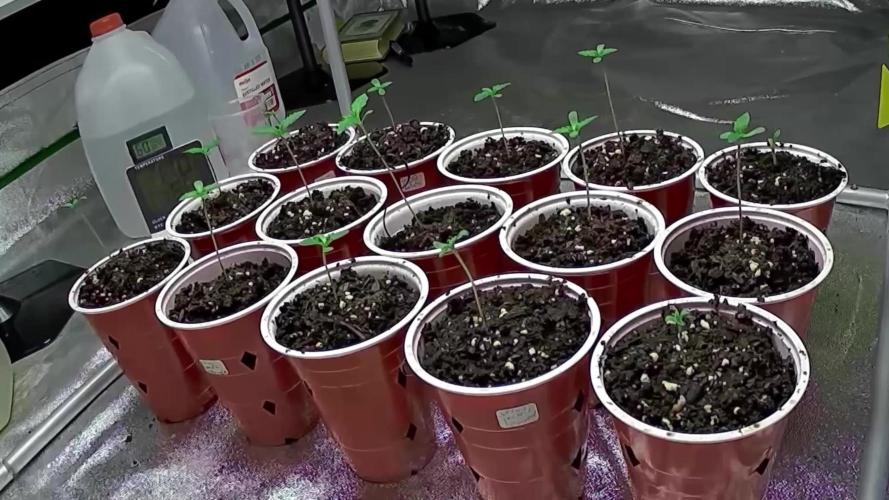The Grow Awards 2026 🏆 





























Likes
1
Share


@Ninjabuds
Follow
Growace.com air cube discount code NINJABUDS
ELUFAH.com and amazon Elufah products discount code NINJABUDS
I finally choose witch 6 plants I am going to keep and I transplanted them into the air cubes
Wedding gelato was a hard one to choose both of the seedlings were both healthy and strong
Also I set up the grow pro’s under canopy lights getting them ready for when the plants are ready for those to kick on
Likes
223
Share


@Tropicannibis_Todd
Follow
💩Holy Crap We Are Back At It And Loving It💩
👉WE R SO CLOSE NOW👈
Growmies we are at DAY 70 and there all just killing💀it👌
The Gorilla Punch Is Amazing 👏 But so is the OG
👉We are in full flowering mode for the👈 OG 👍 GP 👍 the AF was the hold out but shes finally flowering👈
So Shit , I gave them just a tad to much nutes at the start feeding 👈 But I have since fixed it
So I'm still doing some low stress training 🙃 and some defolation 😳
Lights being readjusted and chart updated .........👍rain water to be used entire growth👈
👉I used NutriNPK for nutrients for my grows and welcome anyone to give them a try .👈
👉 www.nutrinpk.com 👈
NutriNPK Cal MAG 14-0-14
NutriNPK Grow 28-14-14
NutriNPK Bloom 8-20-30
NutriNPK Bloom Booster 0-52-34
I GOT MULTIPLE DIARIES ON THE GO 😱 please check them out 😎
👉THANKS FOR TAKING THE TIME TO GO OVER MY DIARIES 👈
Likes
35
Share


@SmokingTiki
Follow
My plants grow well! The leaves issue I get during last week seems to be ok now.
I trained the 4 plants. O.G. Kush and Honey Melon Haze in the begining of the week and the 2 Mandarin Punch on the last day.
O.G. Kush & Honey Melon Haze : topping + LST.
Mandarin Punch : topping only.
I struggled a little bit to maintain a good air humidity. It was oscillating between 50 and 70% but most of the time it was around 60%. I had to use a dehumidifier.
The fan is now "ON" at the same time as the light.
Likes
10
Share


@AokEnt
Follow
Only 7 weeks to go. I'm noticing some leaves are browning. It's mostly leaves that get little light, but I believe it may be over watering. Gonna reduce how often I water for right now.
The plant itself smells little to me, to others its very noticeable. Not skunky at all, more of a cookies and cream scent I believe.
Also slight wpm residue, tried watering thru the leaves because of how low the plant is. Terrible idea.
Likes
14
Share


@GoldenWeedGrower
Follow
D36/V32 - 06/05/23 - SCROG net added. Some LST
D37/V33 - 07/05/23 - LST on SCROG
D38/V34 - 08/05/23 - LST on SCROG
D39/V35 - 09/05/23 - LST on SCROG
D40/V36 - 10/05/23 - LST on SCROG
D41/V37 - 11/05/23 - 👉 Water Change - Pure water for 2 days she's going to bloom
D42/V38 - 12/05/23 - 👉 second day of flush
Processing
Likes
13
Share


@Crazy_zx10r
Follow
About a day into week 3 . Growing very strong and fast. Transplanted into the 5gal bags at night . Over week 3 they exploded. They wanted the room .. the 5gal bags made that happen. Amazing results with just foxfarm ocean forest soil.
Likes
15
Share


@Wenz004
Follow
So finally the wonder of stretch started,)
During my last living soil experiment exactly that did not work.
This time with help of topbooster and P-booster it works good.
Likes
5
Share


@CuriosityWebster
Follow
Really loving the development I’m seeing on these buds in the past week.
Plants are growing vigorously, banana purple punch seem to have a slight deficiency possibly a magnesium deficiency, just kept feeding with pH. Perfect trio seem to bounce back more from it. Both plants are very healthy looking in my opinion.
No signs of mold or powdery mildew
Trying an experiment of using foop mist into nutrient regimen
Likes
32
Share


@LSnake
Follow
I am very satisfied with the germination that took place in a few days. 🌱💪
This week I will continue to keep an eye on the development of the plant to prevent it from stretching too much in the first weeks. 🔍
I use BioBizz Light soil which for the first few weeks manages to provide enough nutrients, so I will water with a little water every day, to keep the humidity a little higher, without running the risk of overwatering. 🌊❌
Likes
2
Share


@DrBud420
Follow
23.05.
today is the end of the fourth week for the plants, they haven't progressed much since last week, they grew a few cm and gained a little weight, but they are healthy, which is the most important thing... in a few days I will transplant them and top them because some of them have already developed the sixth pair of leaves, so I simply have to top them. turned out...
I thought of transplanting them into 10-liter pots and after two to three weeks into 50-liter holes, however, the weather didn't cooperate, and I was already late anyway because of the bad weather, and because of the same, my plants in the fourth week were the same as they should have been in the second, and because of the same, I couldn't even transplant earlier... now that nothing went according to the "plan", of course, I don't know how smart it is to transplant them into 10 L and then into 50 with the fact that it is with me the longest day of the year is June 22, so that actually a week after that it can start flowering (it usually starts at the end of July or at the end of August, but it can be late and start even in September, and it also knows how to plow and start already at the end of June)...now I think that it is better to buy smart pots of 50-60 liters and immediately transplant into them and then just bury them...another problem with that is that the soil that I took for vegetation has food in it for a month days, if I transplant twice, it may happen that it enters flowering, and the food for the vegetation has not yet been used up, and that would be a problem...advices are welcome
Stay high!!!
Likes
48
Share


@BreakingBud
Follow
New harvest pics added!! Amazing strain, this one is in my top 5! I had to make a few adjustments to the harvest results, i had 9 plants in total under a 1000w 4 of them were chocolate mint og the other 5 were bubbas gift. 4 plants taking up less than half the wattage and space works out at around 0.55 GPW
Likes
7
Share


@Reaper
Follow
pistils start to turn brown maybe 2 more weeks before harvest.
some topleaves show calmag issues because i gave too luch bloom booster 2 weeks ago looks wors then it is
Likes
2
Share


@High_Grade_Dadli
Follow
Missed last week update but did some cutting girls have to live up to the mission 73 between the 5 plant....added one more which was a cutting from a seed plant harvested previous...didn't look like I did anything so cut dem a few day later 85 between the same plants... only cut the lower half of G4 n smaller inside branches( going to stop they dont hold up well)
Likes
18
Share


@Diips
Follow
d.57 - looks alright, had to do some lst and adjustments to level out the height
gave an additional biotab.
move my big fan, below the plant, in an effort to push the moisture upwards and out, which resulted in me being able to raise the lights further up.. my plant is way over the average height of is genetics, thanks to biotabs 🌞.
fastbuds said it would have an average height of 70-100 cm, and ny plant is closing in on the 80 cm and she keeps going ^^. and people say that autoflowers cant be main lined, well i believe this grow proves it.
achieved darker folliage in the bottom, so i believe that we are on the right track. hopefully the deficiency levels out.
day 62/63 gave an additional biotab so we are at 6 total. day 63 i gave 10 ml bio pk with the watering.
Likes
51
Share


@Seldom_Seen
Follow
Day 43: Week 7 off to a good start. Watered with just PH’d water. The soil PH is reading 7.0 so I’m bringing the water/feeds closer to 6.0 to try bring it down a bit. Took nearly 4ltrs again. Moved around another 5 cm away from light, just to be safe. I only have around 20cm left to play with so hopefully it doesn’t get much taller.
Day 45: Watered with nutrients (1ml SR, 5ml B) with PH @ 6.3. Took 3ltrs. I measured the PH of run off and it’s reading 7.0. It’s fairly dark down below the canopy and I want to give the plant a break from me clipping leaves off so I’ve added in one 23watt Warm White (2700k) standard home CFL bulb down low. I don’t know how much it will help but it won’t hurt so no harm in sticking it in.
Day 47: Watered with nutrients (1ml SR, 5ml B). Took 3ltrs, run off measured at 7.0. Plant looks happy and healthy which is great considering how much defoliation I’m having to do. I’m thinking now that two 9ltr pots might be too big for my space.
Day 49: Seven weeks old today and looking happy and healthy. Watered with nutrients and added Green Sensation to the feed (1ml SR, 1ml GS, 2ml B). Plant grew 10cm this week. I think the main stretch is over now.


























